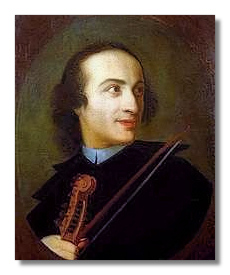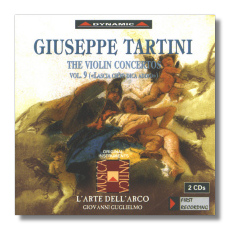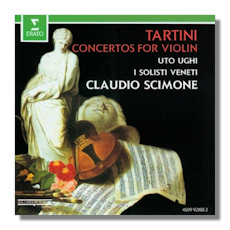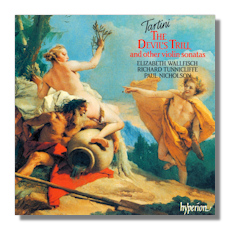
The Internet's Premier Classical Music Source
Related Links
-
Find CDs & Downloads
Amazon - UK - Germany - Canada - France - Japan
ArkivMusic - CD Universe
Find DVDs & Blu-ray
Amazon - UK - Germany - Canada - France - Japan
ArkivMusic-Video Universe
Find Scores & Sheet Music
Sheet Music Plus -
Recommended Links
Site News
Giuseppe Tartini

(1692 - 1770)
Giuseppe Tartini (Pirano, Istria; April 8, 1692 - Padua, Rep. of Venice; February 26, 1770) was an Italian composer, violinist, and theorist who put forth the modern style of bowing for the violin and comprised the principles of musical harmony and ornamentation.
Tartini was the first to recommend improvements to the bow to make possible more skillful movements, opening the way to what is now called bow technique. Violinists before Tartini were satisfied if they were able to modify their playing with f (loud) and p (soft) only. He was often emulated in his playing by other violinists and they sometimes were judged better than Tartini.
Tartini studied divinity and law at Padua and at the same time established a reputation as a fencer. While at seminary he was given violin lessons. His father objected to his violin study and cut off his allowance and he was forced to give violin lessons to make money. There were plenty of violin teachers in Padua but still he had more students than he could cope with. Before the age of 20 he secretly married a fifteen-year-old girl, the cardinal's niece. He ran away to Assisi where he was certain of the protection of Padre Boemo, the 'Bohemian Father', who worked as an organist in the famous Franciscan monastery. Tartini had met the Padre in Padua when the priest was the organist at the church of San Antonio. It turned out that the Padre later would become the composer Gluck's harmony teacher. Padre Boemo asked the abbot of the monastery to offer Tartini refuge, and here Tartini stayed for several years. Life in the monastery was a wholesome experience for the young Tartini. He was consumed by the violin. Padre Boemo instructed him in counterpoint and thoroughbass. Soon he played at church concerts, but had to sit behind a screen in order not to be seen by the Cardinal's informers.
One day the screen blew down and Tartini was seen playing his violin. In the crowd was a man from Padua, who recognized Tartini and told the Cardinal he had seen him. Tartini's wife had stayed behind in Padua and had changed her uncle's attitude. The wife's uncle forgave him and allowed him to return to Padua. From then on his fame grew all over Italy. When Tartini heard the violinist Antonio Veracini in Venice, he sent his wife to stay with relatives in Pirano, and went to Ancona. He remained for a year tirelessly practicing bow exercises because Veracini's fiery play had brought his own shortcomings home to him.
Returning to the concert world, he had no longer any need either to fear or envy any competitor. He was now regarded as Italy's greatest violinist. In 1723, he went to Prague on an invitation to enhance with his art the coronation of the Emperor Charles VI.
Tartini was hired by Count Kinsky as conductor of his private orchestra. He only held this post for three years before resigning and returning to Padua, then spent the rest of his life as leader of the church orchestra of the Cathedral of San Antonio.
His recognition as a teacher was so well known that students from many countries came to him for violin lessons. He was called "master of the nations". Some letters remain which he wrote to a lady explaining the best method for her to use of achieving a perfect stroke of the bow and a royal tone. They are masterly letters, giving clear and simple instruction, and it is regrettable that Tartini never took an interest in writing down his method of teaching violin technique in all its aspects. It would have made an excellent introduction to the art of violin playing.
His compositions include more than 100 violin concertos; numerous sonatas written after 1735; quartets; trios; symphonies; and religious works, including a five-part "Miserere" and a four-part "Salve Regina".
The most popular of his compositions is the so-called "sonata with the devil's trill" (Il trillo del Diavolo). Tartini's story about the sonata goes like this: one night the devil appeared to him in a dream and said "thou art but a cold, unfeeling fiddler, I can do better than that!" Tartini then gave his violin to the devil, who played a very beautiful sonata. Tartini then woke up, but had no memory of the melody; only a strange double-quaver (trill) was still lingering in his ears. He got up that night and wrote the sonata with the devils trill, which was close to that of the Evil One – or so he thought. It is still greatly admired; it begins with a tender, charming "larghetto" full of deep feeling, and is followed by a energetic and witty "allegro" and an "andante" which presents the theme in a broad, emotional mood. Next comes the "allegro" with the famous double quaver, and an "appassionata" completes this gem of violin music. Tartini's G minor sonata, "Didone abbandonata" (abandoned dido), is also a masterpiece in its category. ~Mike Parmer (6/2009)
Recommended Recordings
Concertos for Violin
- Violin Concertos, Op. 1/Dynamic CDS160/1-3 (Volume 1)
-
Carlo Lazari (violin), Federico Guglielmo (violin), Giovanni Guglielmo (violin)/L'Arte dell'Arco
Vol. 2 - CDS190/1-2: Vol. 3 - CDS196: Vol. 4 - CDS220: Vol. 5 - CDS239: Vol. 6 - CDS245: Vol. 7 - CDS279: Vol. 8 - CDS355: Vol. 9 - CDS365/1-2: Vol. 10 - CDS399/1-2: Vol. 11 - CDS445/1-2: Vol. 12 - CDS462/1-2: Vol. 13 - CDS485/1-2: Vol. 14 - CDS548/1-2: Vol. 15 - CDS591/1-2:
- 3 Violin Concertos, D. 56, 96 & 113/Erato ECD88096 reissued as 4509-92188-2
-
Uto Ughi (violin), Claudio Scimone/I Solisti Veneti
Or Erato 4509-92188-2
- 5 Violin Concertos, D. 28, 50, 80, 96 & 125/Naxos 8.570222
-
Ariadne Daskalakis (violin), Helmut Müller-Brühl/Cologne Chamber Orchestra
- 3 Violin Concertos, D. 45, 56 & 86/Novalis 1500922
-
Thomas Furi (violin)/Camerata Bern
Sonata for Violin "Devil's Trill"
- 4 Violin Sonatas including "Il trillo del Diavolo"/Hyperion CDA66430 reissued as CDD22061
-
Locatelli Trio
- 4 Violin Sonatas including "Il trillo del Diavolo"/Harmonia Mundi HMU907213
-
Andrew Manze (violin)

















